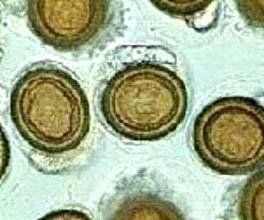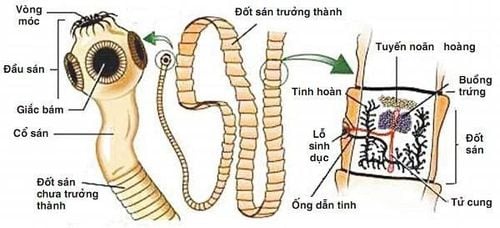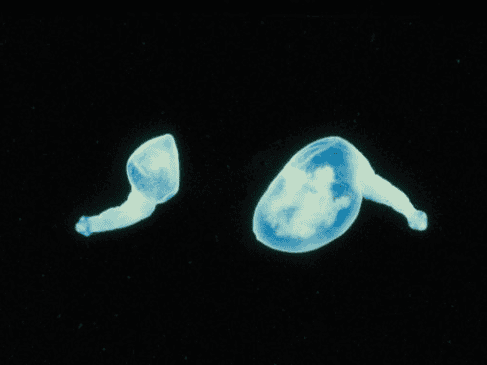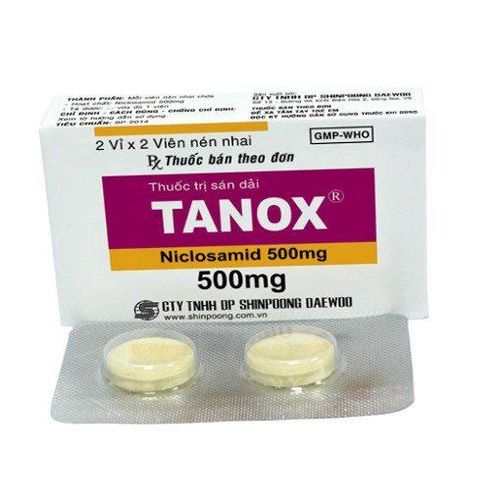This is an automatically translated article.
Article by Resident Doctor Nguyen Thi Thuy Hang - Doctor of Microbiology - Laboratory Department - Vinmec Times City International Hospital
1. Physical characteristics of pork tapeworm
1.1. Adult pork tapeworm
Pork tapeworm 2 - 3 m long (in some cases it can be 8m long), with 300 - 900 segments. The head of the tapeworm is small, slightly rounded, about 1 mm in diameter, with a central protrusion with two hook rings. There are 4 rounded triangles at the four corners.
Neck slender, 5 - 10 mm long. Young body segments, the width is longer than the longitudinal ones, the mature segments are square, the older ones are smaller than the longitudinal ones.
Pork tapeworm birth hole opens next to the sting, sometimes on the right, sometimes on the left, alternating relatively evenly. The cervical segment divides into transverse branches: 6 - 8 - 12 branches filled with eggs.
1.2. Pork tapeworm eggs
There are spheres, larvae inside, 3 pairs of hooks. The outer layer of the eggshell is very thin and when it goes outside, it breaks immediately, the shell right next to the larva is very thick, with a horizontal notch like spokes. The size of the eggs is 31-56 μm. One tapeworm has up to 50,000 eggs. The old nodes at the end of the body often fall off in 5-6 consecutive segments with feces.

1.3. Tapeworm larvae cysts
Cysts are milky white, size 17 - 20 x 7 -10 mm. The cyst contains water and has a tapered head with an inverted cervical vertebra, a head with 4 cups and 2 hook loops.
2. Case definition
2.1. Taenia solium (adult tapeworm)
Due to the patient ingesting uncooked raw pork, blood soup... containing fluke larvae (pork rice). When reaching the stomach, the larvae will escape the cyst and stick to the small intestine and then develop into an adult tapeworm, about 67-72 days later, there are old segments. Adult flukes can live up to 25 years.
2.2. Cysticercus cellulosae (Cysticercus cellulosae):
The cause of infection with tapeworm larvae is caused by people eating infected pork tapeworm eggs in food, after eating or swallowing fluke eggs. When eggs enter the stomach, they will hatch into larvae, reach the small intestine, then the larvae penetrate the digestive tract wall into the bloodstream and move to parasites in some organs in the body, such as muscles, eyes or brain. and will become cystic. Depending on the parasitic location of the cyst, there are different manifestations of the disease.
More common, more severe and dangerous is the case of people with adult tapeworms in the intestines, when burned, they fall off, for some reason such as motion sickness, pregnant women, high fever. .. was vomiting, old tapeworms were shed in the small intestine by peristalsis in the opposite direction to the stomach and this time it was like eating pork tapeworm eggs in very large quantities (self-infection).
3. Symptoms
People with adult flukes have no special symptoms, but depending on the body's response, they may experience bloating, indigestion, nausea, epigastric pain, intermittent loose stools, loss of appetite, and loss of appetite. not delicious or vice versa eat a lot, lose weight. Symptoms of tapeworm infection are usually evident when the tapeworm is in the adult stage. When the appearance of old fluke segments begins to appear in the feces, the clinical manifestations also decrease.
Cases of infection with tapeworm larvae will have papules and lumps on the skin; The appearance of lumps in the orbit, eyelids, in the conjunctiva, the lens. Some cases of parasitic larvae in the brain cause headaches, convulsions, seizures ...
Most of the time, when infected with pork tapeworms, the body will have a mechanism to protect itself and eliminate the larvae of the tapeworm, only some less likely to cause symptoms of the disease.
4. Diagnostic test for pork tapeworm
4.1. Diagnosis of adult pork tapeworm
Diagnostic test methods for adult tapeworm include:
Detection of antigens in feces by ELISA technique. Finding the tapeworm or segments of 5-6 tapeworm segments in the stool, observing the adult fluke segments, the uterine branch has 6-12 transverse branches. It is very rare to see tapeworm eggs in the feces, only when the tapeworm segments are broken for some reason.

4.2. Diagnosis of pork tapeworm larvae
Methods of diagnosing pork tapeworm larvae include:
Biopsy of cysts under the skin to look for tapeworm larvae; Computed tomography (CT Scanner) of the brain looks for specific images (the cysts are fluid nodules with faint dots, 3-5mm in size, sometimes cysts up to 10mm in size, scattered with calcified nodules. chemical); Serological diagnosis (ELISA) detected antibodies and antigens of pork tapeworm larvae in the patient's serum. However, this method often cross-reacts with other tapeworms.

As with most other helminth infections, the diagnosis of tapeworm is based on many factors, a combination of clinical symptoms and laboratory diagnosis. Therefore, as soon as they notice signs of suspected pork tapeworm infection, the patient should go to a reputable medical facility for early diagnosis and treatment.
Please dial HOTLINE for more information or register for an appointment HERE. Download MyVinmec app to make appointments faster and to manage your bookings easily.














